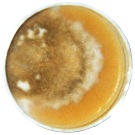 |
|
Research Photo Pages
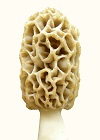
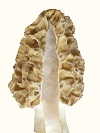
|
Description of Morels Morel mushrooms are highly desired and highly unusual. They evolved from a yeast so recently that they have not acquired a high degree of structural complexity, Such extreme evolution, occurring so recently, creates a biology lesson unlike anything else. It shows how rapid change occurs. The physiology is somewhat scrambled and chaotic, and the morphology is unstable. With artificial growing procedures, morels sometimes acquire a baloon-like appearance with a smooth surface. On agar gel, the mycelium can form an anomaly which looks like colored fur. The Appearance of Morels Morels produce ascospores, which means the spores are enclosed within the tissue, and a force propels them out. Morels, however, are nothing like sponges. They are hollow, rubbery and brittle—much more brittle than other mushrooms. In fact, mushrooms usually have a tough skin over the surface and a fibrous stem. This prevents pieces of mushroom tissue from breaking off. By contrast, morels crumble easy and are often broken—an inadequacy stemming from recent evolution from a yeast. The brittleness is apparently due to round cells which have not yet evolved square corners. Micro-evolution is much more difficult than macro-evolution, because the internal order of the cells would have to change to alter the shape of the cells. Everything within a cell must be precisely located to move reactants from one enzyme to another like an assembly line. Relocating enzymes is not easy. But changing over-all shape is easy, because the only thing that needs to change is the counting of cells in each direction. The cap of the morel has many inadequacies which other mushrooms overcame.
In other words, the use of ascospores by the morel was not a result of advantageous evolution but a disadvantageous carry-over from a yeast.
Strange Physiology Creating a practical growing procedure for morels has been a long term task in science. The first assumption is that they should do what other mushrooms do. They do not, because they are nothing like other mushrooms. The common mushrooms are decay organisms. They produce enzymes on the surface of the mycelium for breaking down large molecules. Morels do not. Instead, morels attack bacteria with acid to feed on them. Under less than ideal conditions, the acid pickles the mycelium. Most filamentous fungi excrete nothing but carbon dioxide, because anything else would be harmful to the mycelium. Mushrooms are usually quite ancient in their evolution, which makes them hardy and easy to handle. Morels are in the infancy of their evolution, which makes them very fragile to handle. But there is more than recent evolution to the difficulties in controlling the growth of morels. Being the physiological equivalent of yeasts, morels are not well adapted to the soil, as mushrooms usually are. Morels may seem to be ubiquitous, but they are environmentally fragile, and they do not disseminate well, as explained in the biology summary. The dissemination problem combined with rapid evolution resulted in morels varying in their appearance from area to area. Morel types are so variable that nomenclature is in a state of confusion. The largest division is between brown and black morels. However, the browns blend into whites, with yellow or tan morels in-between. The blacks also do not create a sharp break from the browns, as various types of grays are in-between. Morels are also highly variable in size and shape. Cylindrical to cone shapes are perhaps the most common. Totally round morels are not uncommon. Pencil shaped morels are more rare. The appearance of morels is specific to an area; and therefore, their identification should include their location. However, they also vary within locations, as shown in the research section. Evolution of MorelsMajor steps in evolution are obscure, because they occur rapidly leaving evidence only of the before and after. The morel mushroom is in a transitional stage of evolution allowing the process to be visible. The result is stunning biology which shows unheard of effects including dramatic phenotypic variations, regional genotypic variations and a reversion anomaly. The morel began evolving from a yeast during the last ice age. Ice ages repeat every 100 thousand years. When the ice was maximum, about 50 thousand years ago, a yeast (Schizosaccharomyces japonicus) evolved at the base of trees and extended into the soil to form the morel mushroom. Yeasts do not tolerate drying, which prevents a yeast from growing at the base of trees under normal conditions. But cold, humid air sweeping off the ice sheet created the humid conditions necessary. A physiological study was needed to pry into these mysteries, because morels, like yeasts, are physiological creatures. The tools of physiology, however, are difficult to apply to mushrooms because of their complex relationship to bulky mediums in which they grow.
|
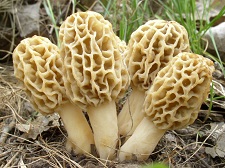 and they have not yet evolved the ability to measure gravity to determine vertical direction. Whatever direction they start growing in is the direction they continue in.
and they have not yet evolved the ability to measure gravity to determine vertical direction. Whatever direction they start growing in is the direction they continue in.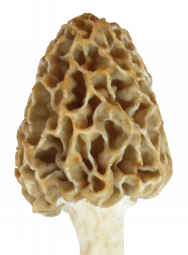 The spores must therefore be near the surface, and a lot of surface area is needed. Ridges and pits increase the surface area creating a sponge-like appearance.
The spores must therefore be near the surface, and a lot of surface area is needed. Ridges and pits increase the surface area creating a sponge-like appearance.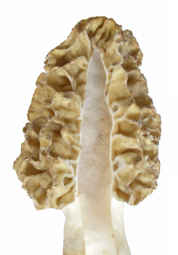 A typical mushroom cap protects spores from being washed away by rain. The morel cap does not. The gills of mushrooms have aerodynamic properties for exploiting wind. Morels cannot use wind nearly as effectively.
A typical mushroom cap protects spores from being washed away by rain. The morel cap does not. The gills of mushrooms have aerodynamic properties for exploiting wind. Morels cannot use wind nearly as effectively.